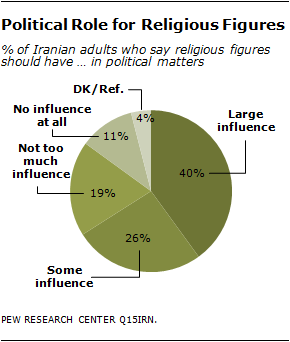As Iranians prepare to elect a new president on June 14, a survey by the Pew Research Center shows that just 40% think religious figures should play a large role in politics. An additional 26% of Iranians say religious figures should have some influence in political matters, while three-in-ten believe they should have little or no influence.
The survey – conducted between Feb. 24 and May 3, 2012 – also found that an overwhelming majority of Iranians (83%) say they favor the use of sharia, or Islamic law. Yet only 37% of Iranian Muslims think their country’s current laws follow sharia very closely. Most say existing laws adhere to Islamic law somewhat closely (45%), not too closely (10%) or not at all closely (3%).
These are among the key findings of a nationally representative Pew Research survey of Iranians. Face-to-face interviews with 1,522 adults, ages 18 and older, also show that most Iranians do not consider religious extremism to be a major problem in their country. Similarly, only minorities say there are widespread tensions or conflicts between more and less devout Muslims, different religious groups, and Sunni and Shia Muslims in their country. Unlike in most countries surveyed by Pew Research, due to political sensitivities it was not possible to ask Iranian citizens to directly rate the performance of their government or religious institutions.
Religion and Politics

Since the 1979 Islamic Revolution, religious leaders have played a major role in the Iranian political system. The Supreme Leader is both the country’s top Islamic cleric and its most powerful political official, while the Guardian Council – a body of religious scholars – can veto any legislation it deems not in accordance with Islam.1
The Pew Research survey finds that most Iranians favor a political system in which religious figures play a role. Nearly two-thirds of Iranians (66%) say religious figures should have at least some influence in political matters, compared with three-in-ten who say they should have little (19%) or no influence (11%).
However, the survey finds that only four-in-ten Iranians say that religious figures should have a large influence in political matters. Overall, younger Iranians are less supportive of religious leaders having a large influence in politics: 35% of those ages 18-34 favor religious figures playing a large political role, compared with 46% of those 35 and older.
In addition to supporting a role for religious figures in politics, roughly eight-in-ten Iranians (83%) say sharia should be implemented in their country, compared with 15% who are opposed to using Islamic law.
When asked how closely Iran’s current laws adhere to sharia, fewer than four-in-ten Iranian Muslims (37%) answer very closely.2 A plurality (45%) says that Iran’s existing statutes adhere to sharia somewhat closely, while 10% say not too closely and 3% say not at all closely. Among the 13% of Muslims who say their country’s laws do not follow sharia closely, nearly eight-in-ten (78%) say Islamic law should be implemented.

Extremism and Religious Tensions
Most Iranians are not particularly concerned about religious extremism in their country. Fewer than three-in-ten (28%) describe themselves as very or somewhat concerned about such extremism, compared with about half (48%) who say they are not at all or not too worried about religious extremist groups. A small proportion of Iranians (14%) volunteer that radical groups do not exist inside Iran’s borders, while one-in-ten offers no opinion.

Asked separately about tensions between Muslims who are more devout and those who are less devout, more than four-in-ten Iranians (44%) say such tensions are very or moderately widespread in their country. This view is somewhat more common among younger Iranians (ages 18-34) than those 35 and older (47% vs. 40%).
Nearly a quarter of Iranians (23%) characterize hostilities between Sunni and Shia Muslims as widespread. But there are sectarian differences in perceptions of tensions between Sunni and Shia Muslims. Among Shias, who comprise about 93% of the country’s population, one-in-five say that such tensions are very or moderately widespread.3 However, among Iran’s minority Sunni population, about half (47%) hold this view.

Although nearly all Iranians are Muslim, when asked more generally about conflict between religious groups, three-in-ten Iranians say that such hostilities are widespread in their country.4
Methodology
Results for the survey in Iran are based on 1,522 face-to-face interviews conducted from Feb. 24 to May 3, 2012, in the respondent’s place of residence. The survey is nationally representative of the country’s non-institutional, adult population (ages 18 and older). It uses a multi-stage cluster sample design stratified by region and urbanity.
Accounting for the design effect, the margin of sampling error is ±3.2 percentage points. For the results based on the full sample, one can say with 95% confidence that the error attributable to sampling and other random effects is plus or minus the margin of error. In addition to sampling error, one should bear in mind that question wording and practical difficulties in conducting surveys can introduce error or bias into the findings of opinion polls.
The survey questionnaire was designed by the staff of the Pew Research Center’s Forum on Religion & Public Life, checked through back-translation and pretested prior to fieldwork. Interviews were conducted in Farsi (Persian), Kurdish, Turkish, Gilaki, Baloch, Luri and Arabic. Fieldwork was managed by Opinion Research Business International.
Footnotes:
1 See Iran’s Constitution (1979) Articles 72, 85, 91, 94, 96 and 110. (return to text)
2 This question was asked of Iranian Muslims only. All other questions in this report were asked of all Iranians. (return to text)
3 The percentage of Iran’s population that is Shia is from the Pew Research Center’s January 2011 report “The Future of the Global Muslim Population.” (return to text)
4 The percentage of Iran’s population that is Muslim is 99.5% according to Pew Research Center’s December 2012 report “The Global Religious Landscape.” (return to text)
Photo Credit: © Manca Juvan/In Pictures/Corbis





